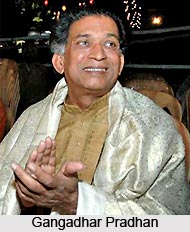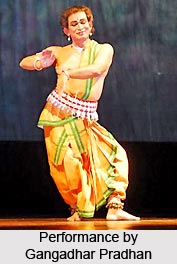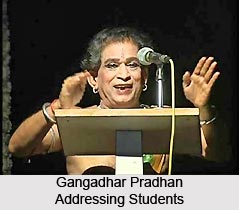 Gangadhar Pradhan was a legendary Odissi exponent and teacher. He was also an actor, mardal player and choreographer. Pradhan made a significant contribution to Odissi dance as a teacher. He founded the Konark Natya Mandap in Konark Puri in 1986. He had several leading dancer-disciples spread across the country. Throughout his lifetime, he had organized several dance festivals in the temple city. He was the first person from the field of Orissan art and culture who was awarded the prestigious assignment of teaching at Cornell University. He was the recipient of many awards including the Sangeet Natak Akademi Award and the Padma Shri.
Gangadhar Pradhan was a legendary Odissi exponent and teacher. He was also an actor, mardal player and choreographer. Pradhan made a significant contribution to Odissi dance as a teacher. He founded the Konark Natya Mandap in Konark Puri in 1986. He had several leading dancer-disciples spread across the country. Throughout his lifetime, he had organized several dance festivals in the temple city. He was the first person from the field of Orissan art and culture who was awarded the prestigious assignment of teaching at Cornell University. He was the recipient of many awards including the Sangeet Natak Akademi Award and the Padma Shri.
Early Life of Gangadhar Pradhan
Pradhan was born on 10 July 1948 in a village called Parikula (off Brahmagiri) in Orissa (now Odisha) state of India. His parents were Muralidahr Pradhan and Dwitika Devi.
Education and Career of Gangadhar Pradhan
When Pradhan was little over five, he was sent to serve the Lord Balunkeshwar. After that, he went on to remain in temple and serve Lord Shiva as a devotee for a long 10 years. Like other boys, there he was taught to do his own chores, look after the harvest, study and take lessons of dance as a Gotipua dancer. In this dance form, boys dress up like girls to perform.
His quest for learning was immense and he was a quick learner. In the temple, only senior boys were allowed to learn the musical instrument Mardal. However, he sneaked out opportunities to play Mardal, when the seniors worked at the paddy fields.
The family and teachers of Pradhan recognized his talents and advised him to go out into the broader world to seek knowledge and sharpen his skills. This encouragement led to his arrival in Bhubaneswar in 1966 and his admission into Utkal Sangeet Mahavidyalaya. There Pandit Chandrasekhar Pattnaik, landlord of Dimirisena inspired and motivated him to strengthen his talents. He also drew strength from Singhari Shyamsundar Kar, his Mardal Guru, Odissi dance from Guru Pankaj Charan Das, Guru Debaprasad Das and Dr. Minati Mishra.
However, life at college was not easy for Pradhan and other students as they never received their stipends regularly. His family too was not able to provide him financial support as they were poor. Thus, the students saw dance and music as a loathsome profession.
 To meet the cost of their expenses, they had to both study and earn. Pradhan worked for hours to make himself prominent among other students. His additional talent as a Mardal player also supported him a lot. His teachers were depended on him in absence of an accompanist. He started receiving invitations from parents of girl students to accompany their daughters for practice. This gave him the confidence of teaching. Thus, he started teaching students privately.
To meet the cost of their expenses, they had to both study and earn. Pradhan worked for hours to make himself prominent among other students. His additional talent as a Mardal player also supported him a lot. His teachers were depended on him in absence of an accompanist. He started receiving invitations from parents of girl students to accompany their daughters for practice. This gave him the confidence of teaching. Thus, he started teaching students privately.
The golden opportunity came when he got to play Mardal for the noted dancer Rita Devi while he was still in 3rd year and went to Bombay (now Mumbai). This opportunity opened many doors for him and he started participating in many programmes. He started receiving offers from Oriya film producers, opera proprietors, theatre managers to direct dance sequences in their plays and films. He finally completed his Nrityacharya degree course in 1971.
After receiving national scholarship under Padmabibhusan Guru Kelucharan Mohapatra, he took further two years training in Odissi dance and trained himself in mastering the Mardal. During this period, he was actively associated with many organizations like Bhubaneswar Kalakendra, Sangeeta of Jatni, Chilika Sangeet Parishad, Balugaon, etc. He directed and choreographed many dance items while directing the annual day events of numerous schools, colleges etc. In 1969, he got involved in Ekamra theatres. It was then that he found a great patron within Kamala Lochana Mohanty of Ekamra theatres.
Orissa Dance Academy
In 1973, after drawing help from Pt. Raghunath Panigrahi, Late Smt Sanjukta Panigrahi, etc, he started an organization called `Natyaloka`. However, the name was later changed to `Sunati` and finally in 1975 to Orissa Dance Academy. At the outset, classes were not sufficient enough to make the expenses. Pradhan started neglecting his family, his comfort, his health. He had just one goal - to establish a dance institution.
The golden era of Orissa Dance Academy began in 1978 when Gangadhar Pradhan and Aruna Mohanty participated in the India festival held in Germany and Belgium. In 1980, many of his students were sent on a cultural delegation by ICCR with Mr. Dhiren Pattnaik as the team manager to Portugal, Spain, Holland and Italy.
From 1980 to now, this academy has blossomed into a flower and has become one of the premier cultural institutions of India. It has about 300 students and a strong performing unit of about 30 competent dancers.
Pradhan breathed his last on October 11, 2010 in the state capital of Bhubaneswar.
Awards of Gangadhar Pradhan
For his immense contribution in the field of art and culture, he was honoured with myriad awards and felicitations from many reputed organizations of India and many foreign countries. Some of his awards are as follows-
•In 1969, he was awarded first prize in Odissi Dance Competition organized by Odissi Bikasha Pratisthana.
•In 1985, he was felicitated by Museumsassm of India.
•In 1988, he earned the Title of Honorary Citizenship from the Mayor, City of Baltimore.
•In 1990, he earned Chilika Ratna by Brahmagiri Yubajyoti Sahitya Sansad.
•In 1993, he won State Sangeet Natak Akademi Award.
•He won Central Sangeet Natak Akademi Award in 1997

•He was awarded by Shree Nilachala Nikhilotkala Pala Gayaka Parishad in 2000.
•He earned Nrutya Pratibha Samman in 2001.
•In 2002, he was honoured with Bishesh Samman by Sulekha Sahitya Sanskruti Parishad.
•He earned State Level Sadbhabana Award in 2002.
•He was declared Pride of India in 2003 by Asha Memorial Trust.
•He earned Nataraj Samman and Desharatna Samman in 2004.
•He won Bibiddha Barna Cultural Award in 2005.
•He was honoured with Music Achievement Award by OSA Southwest Chapter in 2005.
•He won Mayadhar Mansingh Centenary Award in 2006.
•He earned Chira Sandhhan Samman in 2008.
•In 2008, he was also honoured with Padmashree by Govt. of India.
•He earned Doctorate from Utkal University, Odisha in 2010.



















